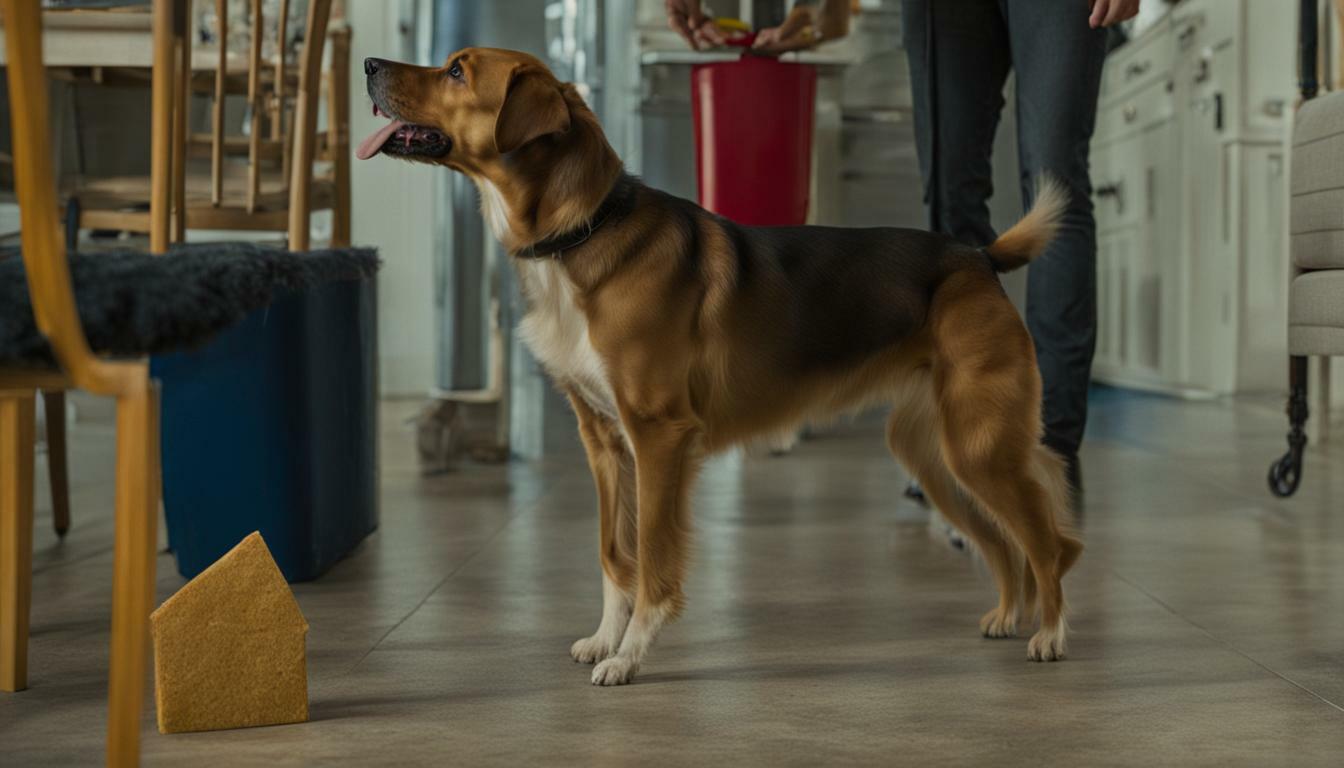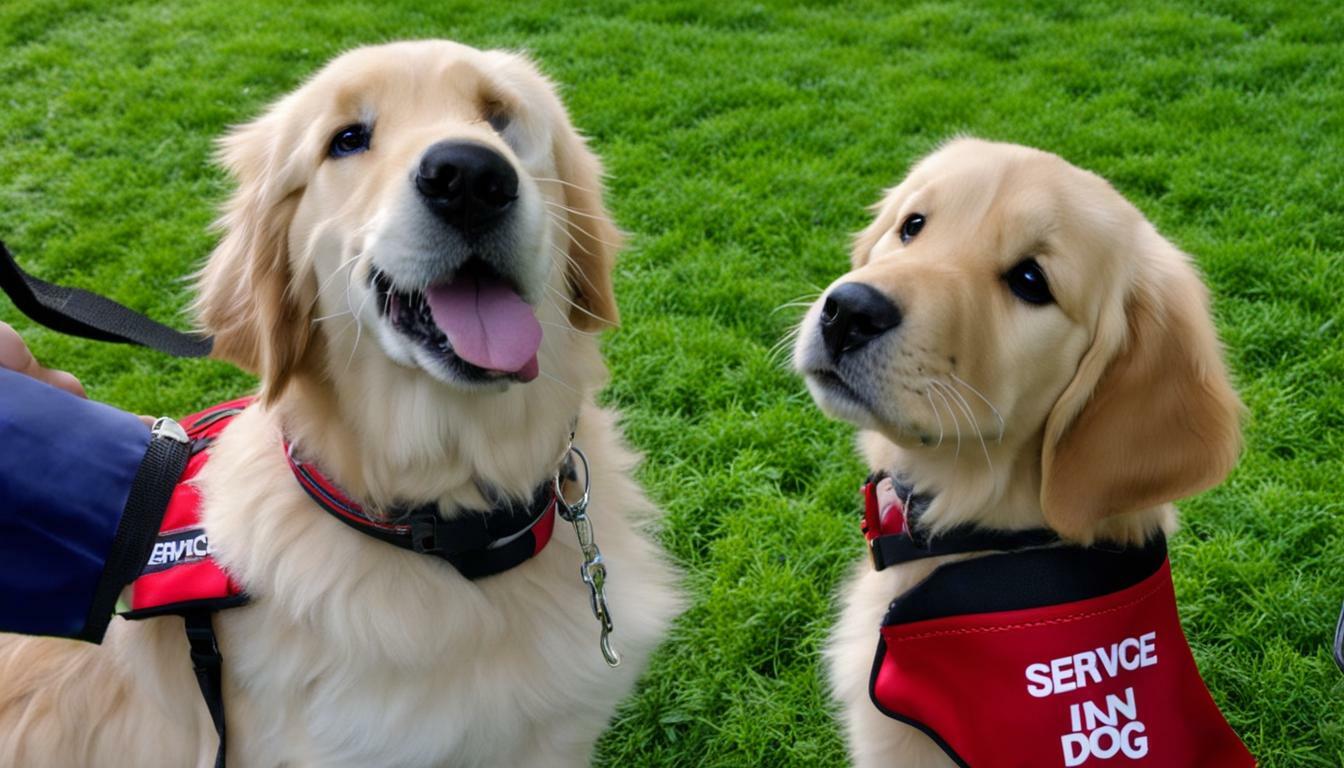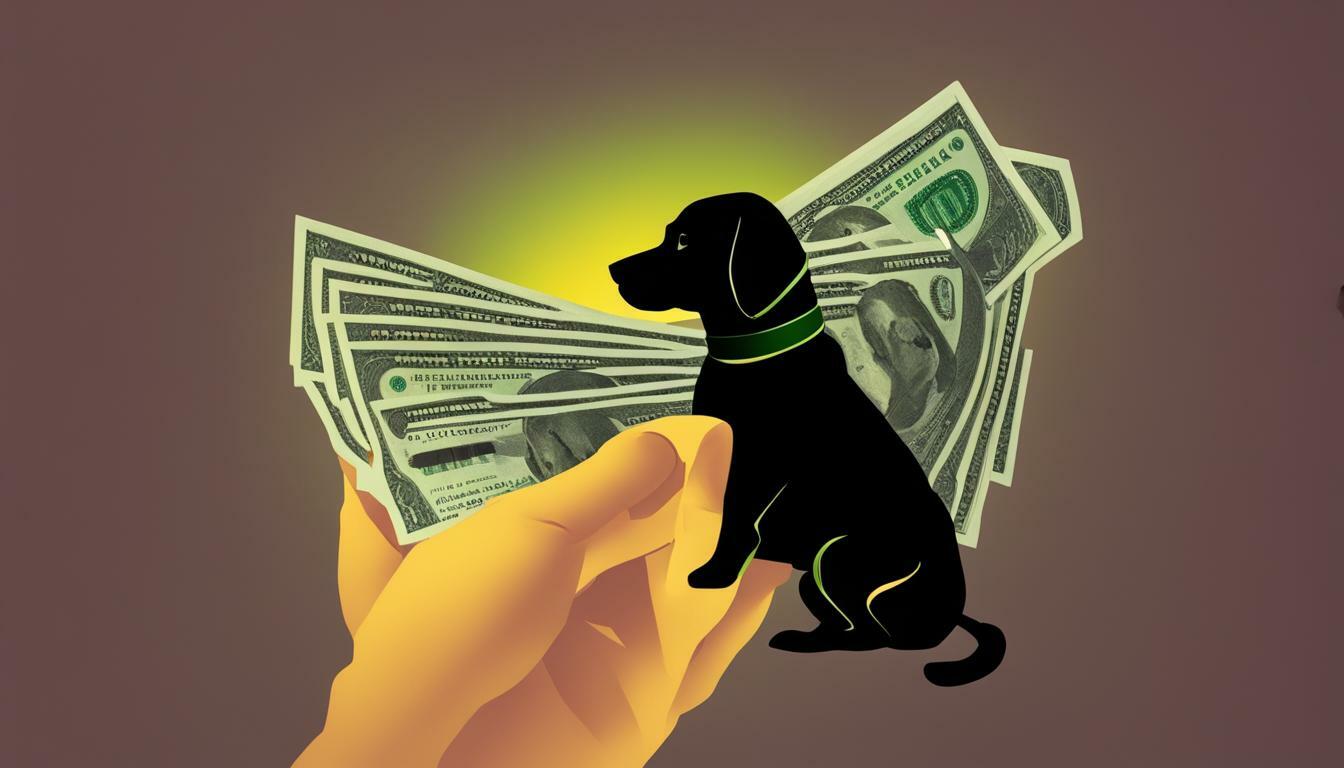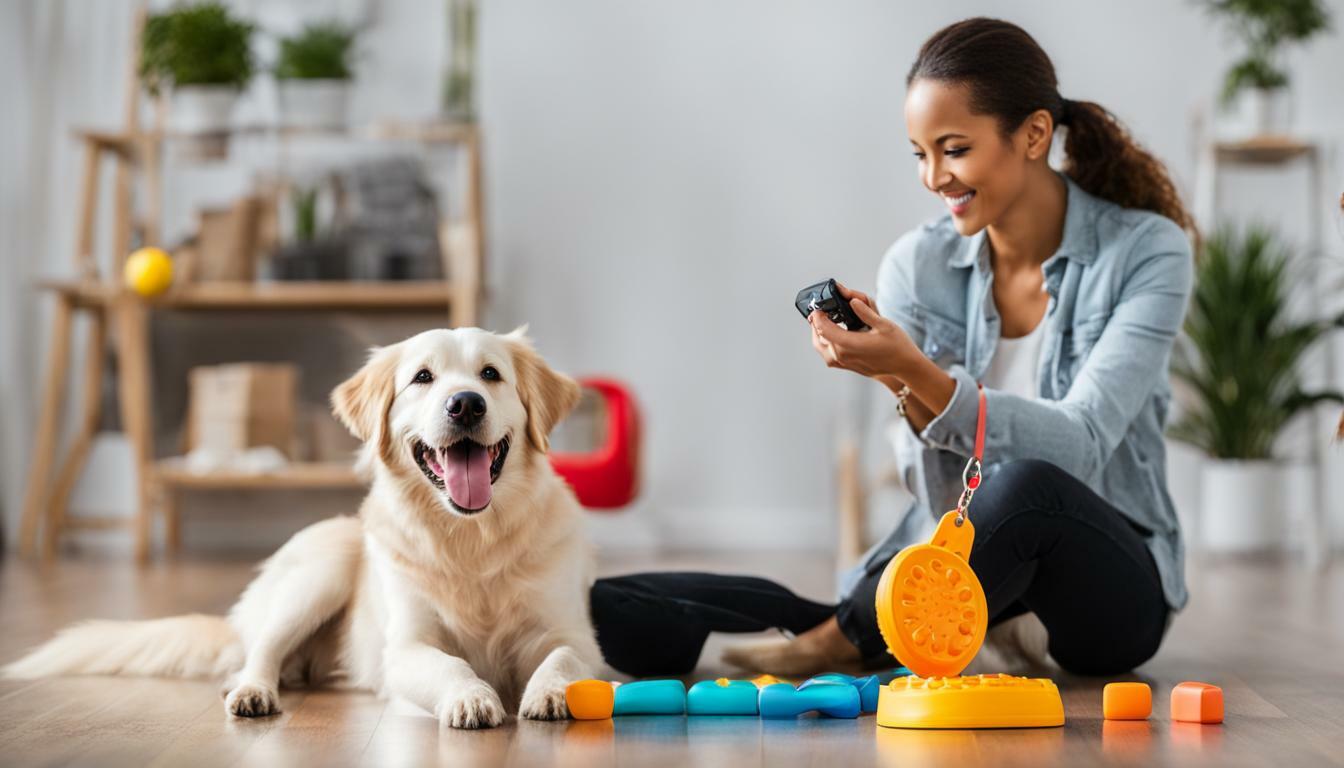Are you tired of your furry friend’s unwanted behaviors? From jumping on guests to excessive barking, it’s understandable that you may want to put an end to these issues. Fortunately, training your dog to stop unwanted behaviors can be quick and easy with the right techniques.
In this guide, we’ll provide a comprehensive overview of how to train a dog to stop. You’ll discover effective tips and tricks to help you achieve a more peaceful home environment.
- Training your dog to stop unwanted behavior can be simple and quick with the right techniques.
- By mastering the art of dog training, you can achieve a more peaceful home environment.
- In this guide, you’ll learn valuable tips and tricks to help you stop unwanted behaviors.
- Positive reinforcement is a proven and humane approach to dog training that can produce effective results.
- Consistency and persistence are key to successful dog training.
Understanding the Importance of Dog Training
Dog training is an essential aspect of responsible pet ownership. It’s not just about teaching your dog cool tricks; it’s about building a strong foundation of obedience and preventing unwanted behavior. Dog obedience training techniques are designed to promote positive behavior and foster a deep bond between you and your furry friend.
Preventing unwanted dog behavior is crucial for maintaining a harmonious home environment. A well-trained dog is less likely to engage in destructive or harmful behavior. Dog obedience training techniques can help prevent issues such as biting, chewing, digging, and aggression. Through training, you can teach your dog how to behave appropriately in various situations.
Training your dog can also benefit their physical and mental health. Regular exercise and mental stimulation can improve their overall well-being. Additionally, training can help your dog feel more comfortable and confident in different environments, leading to reduced stress and anxiety.
Overall, understanding the importance of dog training is the first step to a well-behaved and happy canine companion. By implementing effective dog obedience training techniques, you can prevent unwanted dog behavior and build a strong bond with your furry friend.
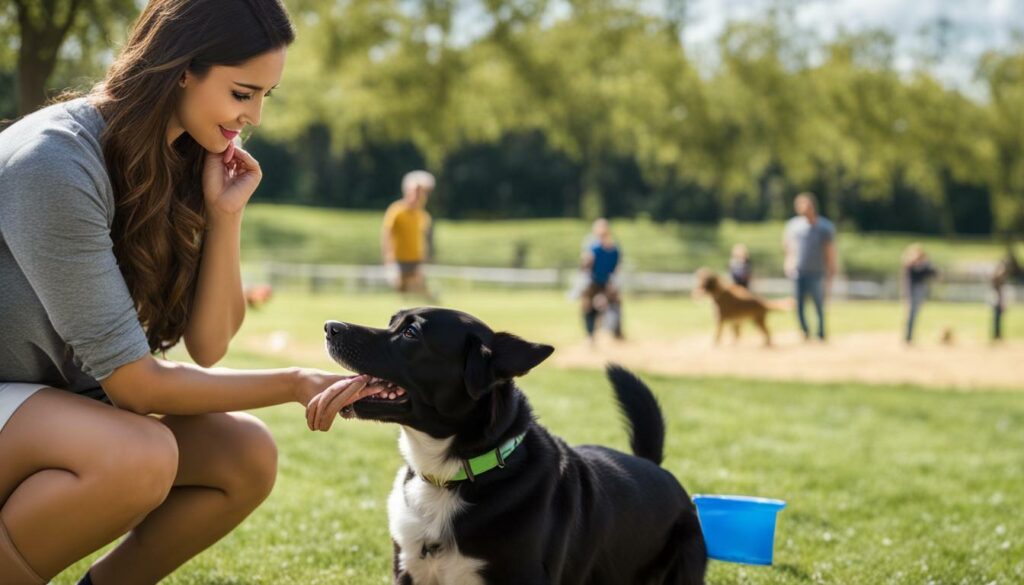
Training your dog to stop unwanted behaviors requires a foundation of trust and a strong leader. By establishing yourself as a leader, your dog will learn to respect and follow your commands. This can help teach your dog to stay calm and focused, redirecting their energy to positive behaviors. Here are some dog training tricks to stop unwanted behaviors:
- Use positive reinforcement: Reward your dog for positive behaviors, such as staying calm, following commands, and exhibiting self-control.
- Be consistent: Use the same cues and commands consistently to help your dog understand what is expected of them.
- Show your dog affection: Physical touch, such as petting or hugging, can help to build a bond of trust and affection with your dog.
- Treat your dog like a member of the family: Include your dog in family activities and provide them with plenty of exercise and playtime. This can help to reduce stress and anxiety, promoting calm behavior.
Teaching your dog to stay calm and focused is an essential part of stopping unwanted behaviors. By using positive reinforcement, being consistent, showing affection, and treating your dog like a member of the family, you can build a strong foundation of trust and leadership that will help you achieve your training goals.
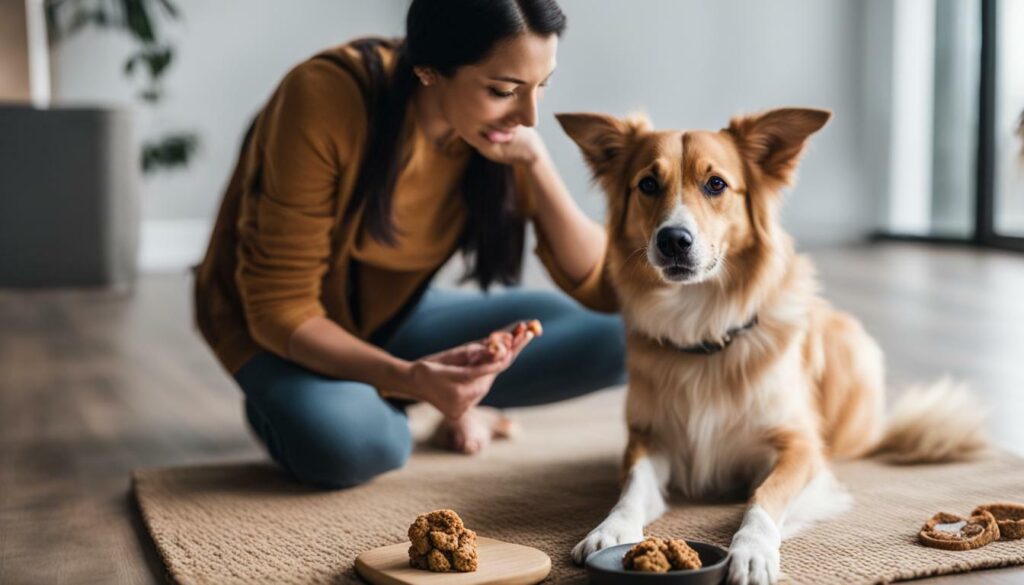
If you want to train your dog to stop unwanted behavior, positive reinforcement is one of the most effective and humane approaches. This training method relies on rewarding good behavior with treats, praise, or playtime, while ignoring or redirecting undesirable behavior. By rewarding your dog when they exhibit desirable behavior, you are reinforcing that behavior and encouraging them to continue it.
When it comes to dog training tips for stopping behavior, positive reinforcement is a powerful tool. Here are some effective ways to train a dog to stop unwanted behaviors:
- Redirect your dog’s attention: Instead of scolding your dog for bad behavior, redirect their attention to an appropriate activity. For example, if your dog is chewing on your shoes, give them a chew toy instead.
- Set clear boundaries: Dogs thrive on routine and structure. Establish clear rules and boundaries for your dog to follow, and consistently reinforce them.
- Be consistent: Consistency is key when it comes to positive reinforcement. Reward your dog every time they exhibit the desired behavior, and never reward bad behavior.
- Use high-value treats: Use treats that your dog loves to reinforce good behavior. This could be a special treat or a favorite toy.
- Keep training sessions short: Dogs have short attention spans, so keep training sessions to 10-15 minutes at a time. This will help keep your dog focused and engaged.
By using positive reinforcement techniques, you can effectively train your dog to stop unwanted behaviors. Remember to be patient and consistent, and always reward good behavior. With time and practice, your dog will learn to exhibit desirable behavior, making them a well-behaved and enjoyable companion.
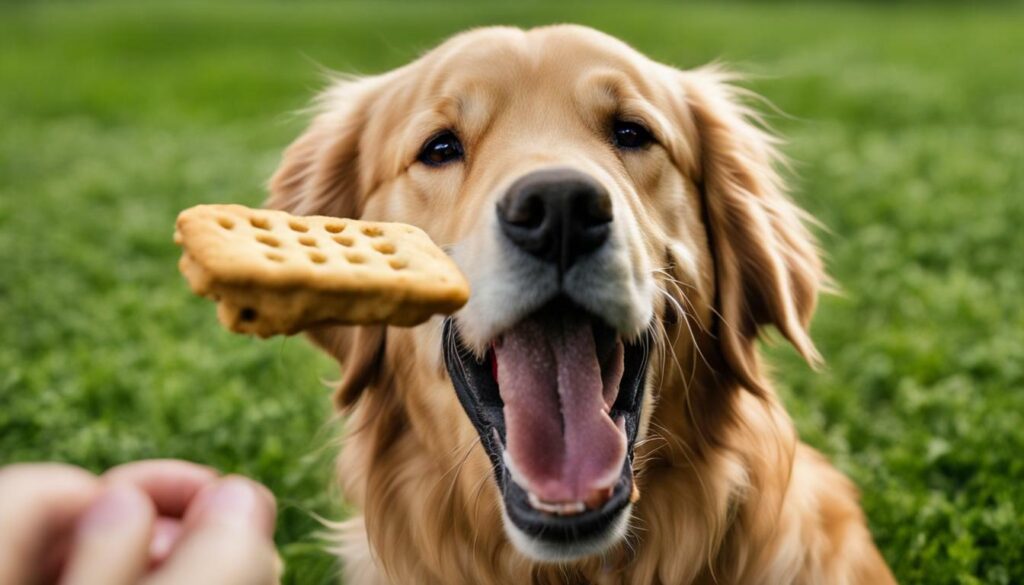
One of the most crucial skills to teach your dog is the “stop” command. Training your dog to respond to this command can help prevent them from engaging in unwanted behaviors such as chasing after a squirrel or approaching another dog too aggressively.
The key to successful training is consistency and positive reinforcement. To begin, choose a word or phrase that you want to use as the “stop” command, such as “halt” or “enough.” Use this command consistently whenever your dog engages in unwanted behavior.
When your dog responds to the command, reward them with a treat or verbal praise to reinforce the behavior. It’s also essential to practice the command in a variety of situations so that your dog understands that the command applies in all situations.
Remember, it takes time and patience to train your dog to respond to the “stop” command consistently. With consistency and positive reinforcement, your furry friend will learn to stop unwanted behavior and make both of your lives easier.
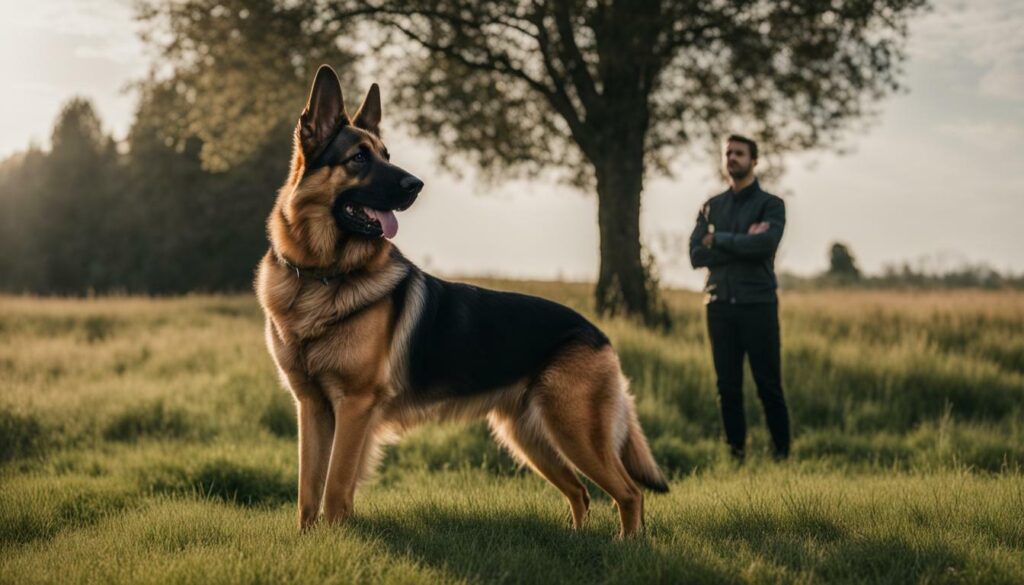
Effective ways to train a dog to stop include consistency, positive reinforcement, and practicing the command in different situations.
Putting an End to Jumping Behavior
Jumping behavior is a common problem among dogs, and it can be a frustrating and potentially dangerous behavior. If your dog jumps on visitors, children, or strangers, it is important to address this behavior promptly to avoid injuries or inconvenience.
Here are some dog training tips for stopping behavior:
| Technique | Instructions |
|---|---|
| Ignore the behavior |
|
| Teach an alternative behavior |
|
| Teach the “off” command |
|
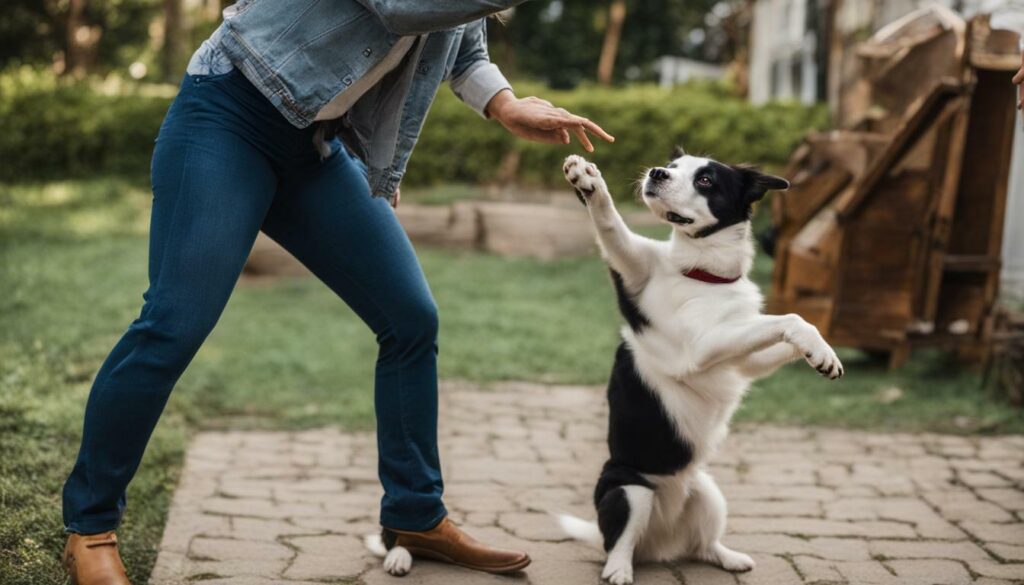
Remember that consistency is key when it comes to stopping jumping behavior. Make sure everyone in your household follows the same techniques to prevent confusion and promote successful training.
Curbing Excessive Barking
Excessive barking can be a frustrating and disruptive behavior in dogs, especially when it disturbs your peace and that of your neighbors. Dogs may bark for various reasons, including boredom, anxiety, or aggression. Regardless of the cause, it’s essential to curb excessive barking to promote a harmonious environment for everyone.
Here are some effective dog training tips for stopping excessive barking:
- Teach the “quiet” command: Just like any other command, you need to train your dog to understand what the word “quiet” means. Firstly, wait for your dog to bark. Then, give the verbal cue “quiet” and wait for your dog to stop barking. When your canine companion stops, praise and reward with a treat. With time and practice, your dog will understand that “quiet” means to stop barking.
- Avoid rewarding bad behavior: Do not give your dog attention or treats when they bark excessively. Doing so may reinforce the behavior. Instead, wait until they stop barking before giving praise or rewards.
- Identify the cause: Excessive barking may be a symptom of an underlying problem. If your dog barks excessively when outside, they may be experiencing anxiety. In contrast, if they bark at specific times, such as during mealtime, they may be trying to communicate with you. Once you understand the cause, you can address the problem and curb excessive barking.
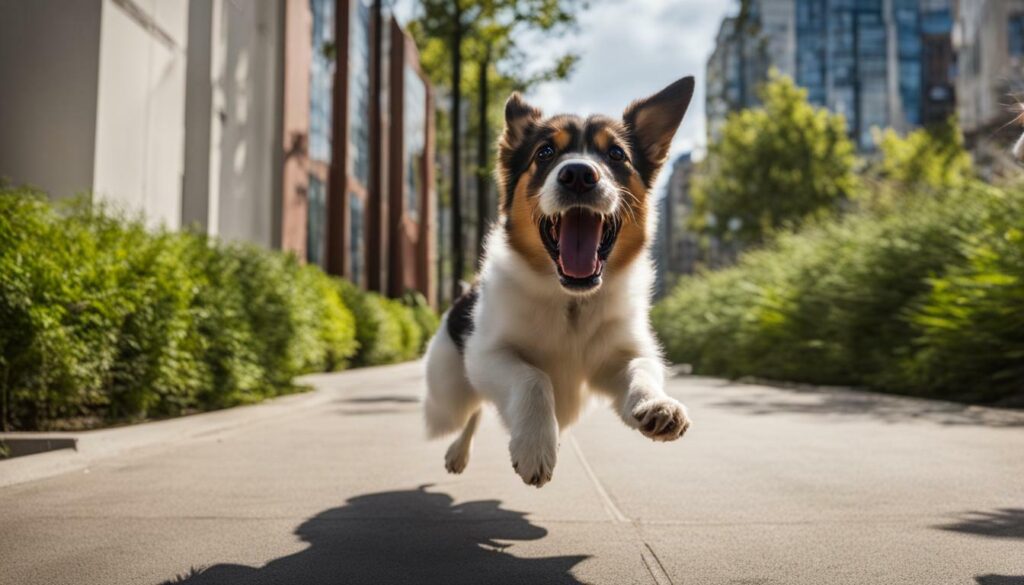
Remember that training your dog is a gradual process. Consistency and persistence are key to success. Reward good behavior and remain patient and firm when addressing bad behavior. Seek professional help if necessary to address complex problems.
Addressing Separation Anxiety
Separation anxiety is a common issue for many dogs and can manifest in destructive behaviors such as excessive barking, chewing, and urinating in the house. Fortunately, there are steps you can take to prevent and address separation anxiety.
One of the most effective ways to prevent separation anxiety is to gradually acclimate your dog to being alone. Start with short periods of time and gradually increase the duration. You can also make your dog’s alone time more enjoyable by providing a comfortable space and plenty of toys and treats.
If your dog is already experiencing separation anxiety, it’s important to address the root cause of the behavior. It may be helpful to consult with a professional dog trainer or behaviorist to determine the best approach for your specific situation.
Some dog training tips for stopping separation anxiety include:
- Establishing a consistent routine for your dog
- Teaching your dog to associate being alone with positive experiences
- Using calming aids such as pheromone sprays or calming music
- Avoiding punishment for anxious behaviors
By taking a proactive approach and using effective dog training tips for stopping separation anxiety, you can help your furry friend feel more comfortable when left alone and prevent destructive behaviors.

Dogs can be impulsive creatures, prone to acting on their instincts without thinking. However, impulse control is an essential skill for a well-behaved canine companion. By teaching your dog patience and self-control, you can help them make better decisions and stop unwanted behaviors from occurring.
Effective ways to train a dog to stop:
| Technique | Description |
|---|---|
| Wait for the Click | This technique involves clicking a training clicker when your dog exhibits a desirable behavior, such as sitting patiently. Over time, your dog will learn that the sound of the clicker indicates good behavior and will work to earn the click. |
| Teach “Leave it” | This technique involves teaching your dog to ignore tempting items or behaviors, such as food or other animals. Start by showing your dog an item and saying “leave it.” Reward your dog with a treat for ignoring the item and gradually increase the difficulty of the exercise. |
| Practice “Stay” | This technique involves teaching your dog to stay in place, even when tempted to move or follow a command. Start by having your dog stay in place for a few seconds, gradually increasing the duration. Reward your dog with a treat for successful stays. |
Using these techniques, along with patience and persistence, you can train your dog to exhibit better impulse control and respond to your commands promptly.
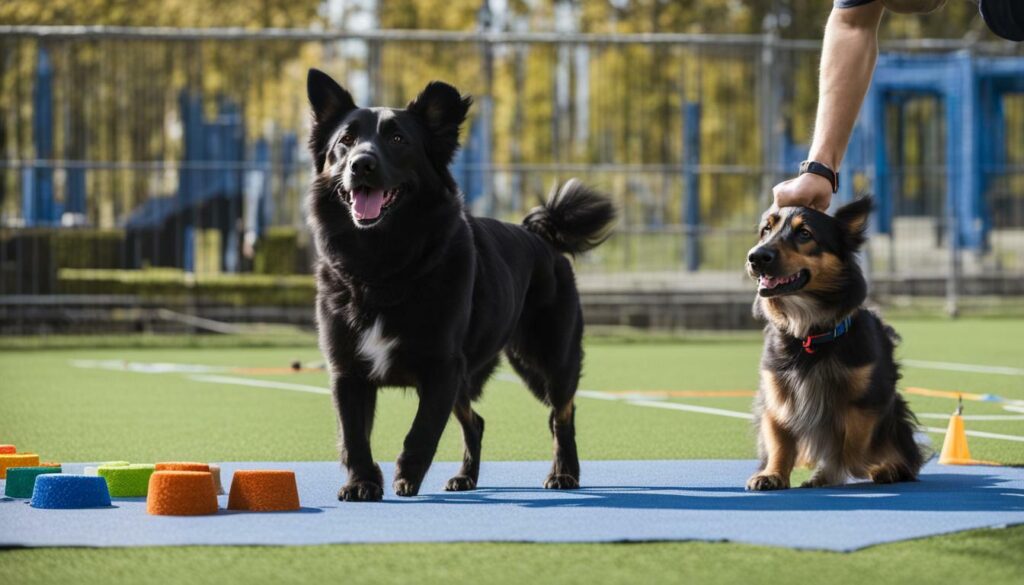
Aggressive behavior in dogs can be concerning and dangerous, and requires immediate attention. Preventing unwanted dog behavior is critical in curbing aggression and ensuring the safety of your household and others. Effective ways to train a dog to stop aggressive behavior involve a combination of techniques that address the root cause of the aggression, and careful management to prevent future incidents.
There are several common reasons for aggressive behavior in dogs, including territoriality, fear, pain, and lack of socialization. It’s essential to identify the cause of your dog’s aggression to determine the appropriate course of action.
If your dog is exhibiting aggressive behavior, it’s crucial to seek professional guidance from a dog behaviorist or trainer. They can evaluate the situation and provide individualized training and behavior modification plans to address your dog’s specific needs.
Preventing unwanted dog behavior often involves building trust and establishing a strong leader-follower relationship. Positive reinforcement training techniques, such as clicker training, can be effective in teaching your dog alternative behaviors to replace aggressive tendencies. By rewarding good behavior, your dog learns what is expected of them in a positive and non-threatening way.
Effective ways to train a dog to stop aggressive behavior include leash training, practicing proper socialization, and managing their interactions with other people and animals. Leash training can help you control your dog’s behavior when out in public or in situations that may trigger their aggression. Proper socialization involves exposing your dog to a variety of people and animals in a controlled environment, to help them become comfortable in different situations.
Remember, counteracting aggressive behavior requires patience, consistency, and persistence. If you’re struggling with aggression issues in your dog, don’t hesitate to seek professional help. With the proper training and management, you can help your dog overcome aggressive tendencies and create a safe and harmonious home environment.
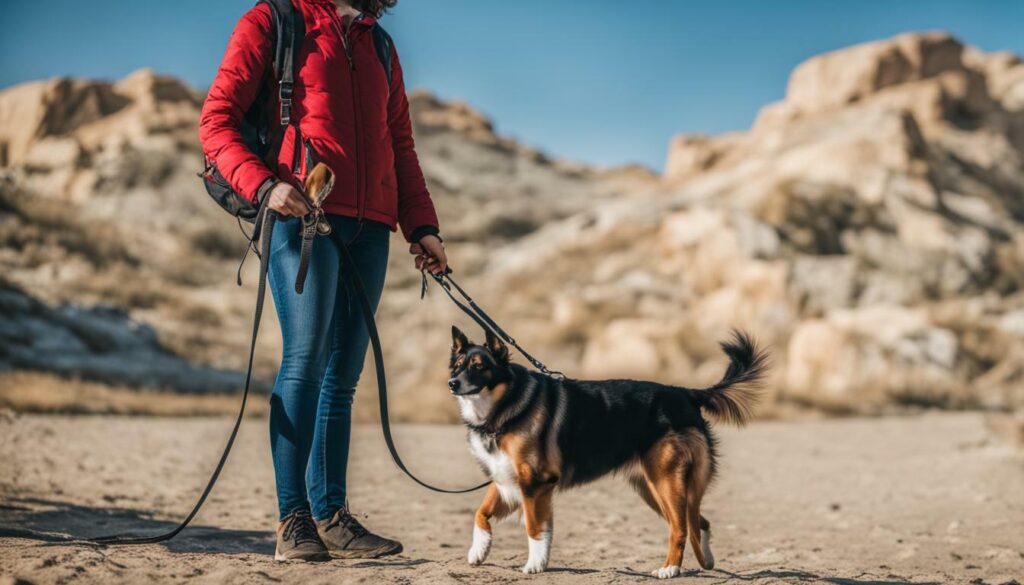
Does your dog pull on the leash during walks, making it an unpleasant experience for both of you? Leash pulling is a common problem that can be resolved with patience and consistency. Follow these dog training tips for stopping behavior and learn effective ways to train your dog to stop pulling on the leash.
Choose the Right Equipment
The first step in addressing leash pulling is choosing the right equipment. Using a collar or harness that fits well and is comfortable for your dog is essential. A front-clip harness or head collar can be particularly helpful in preventing pulling behavior. These devices gently discourage your dog from pulling and redirect their attention back to you.
Start with Short Walks
Beginning small is essential when it comes to leash training. Start with short walks in quiet areas without any distractions. Gradually increase the distance and duration of your walks, and add more significant challenges such as encountering other dogs or people, only when your dog is ready.
Use Positive Reinforcement
Positive reinforcement is the most effective way to encourage good behaviors and discourage bad ones. When your dog walks politely on the leash, reward them with treats, praise, or toys. If your dog starts pulling, stop walking and wait for them to calm down. When they do, reward them with positive reinforcement.
Remember to be patient and persistent in your training. It may take time for your dog to learn how to walk politely on the leash, but with consistency and positive reinforcement, they will eventually get there.
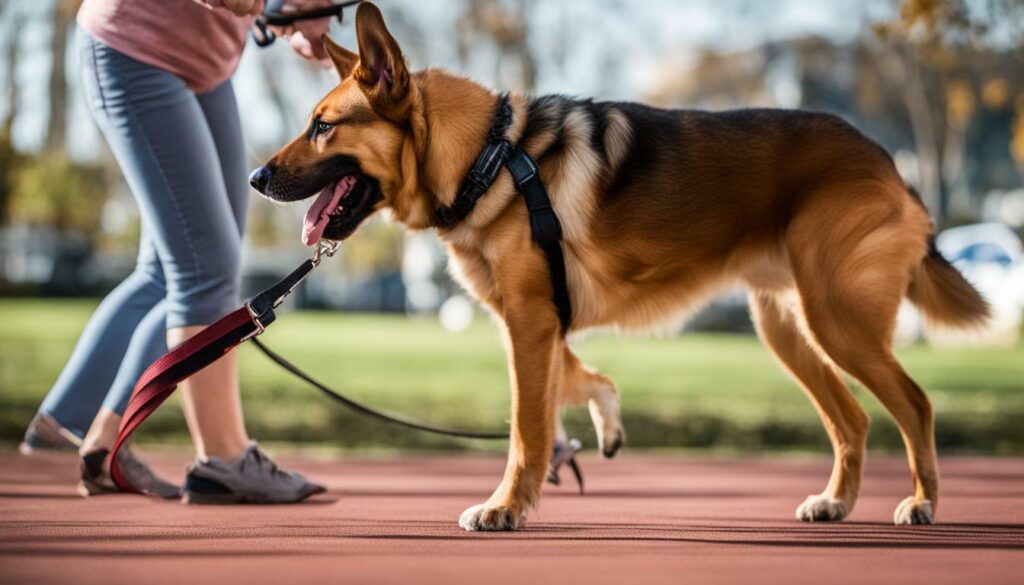
By implementing these dog training tips for stopping behavior, you can train your furry friend to walk politely on the leash. Say goodbye to unpleasant walks and hello to enjoyable strolls with your well-behaved canine companion.
Overcoming Fear and Anxiety
Fear and anxiety can significantly impact a dog’s behavior and well-being. If left unaddressed, these issues can escalate into problematic behaviors such as aggression and destructive chewing. As a responsible dog owner, it’s your duty to help your furry friend overcome fear and anxiety.
One effective way to prevent unwanted dog behavior is to identify the triggers that cause fear and anxiety. It could be loud noises, unfamiliar people or animals, or separation from their owner. Once the trigger is identified, desensitization and counter-conditioning techniques can be used to help the dog become less anxious and fearful in those situations.
In desensitization, the dog is gradually exposed to the trigger at a safe distance until they no longer show signs of fear or anxiety. Counter-conditioning involves pairing the trigger with positive experiences such as treats or toys to help the dog associate it with something pleasant.
It’s important to be patient and consistent when working with a fearful or anxious dog. Rushing the process or forcing the dog to confront the trigger can make the problem worse. Positive reinforcement techniques such as rewards and praise can encourage the dog to remain calm and relaxed during training sessions.
Seeking the help of a professional dog trainer may also be beneficial in addressing fear and anxiety in dogs. They can offer specialized training techniques and guidance to help the dog overcome their issues in a safe and effective manner.
Remember, preventing unwanted dog behavior involves understanding your dog’s needs and working with them to create a positive and stress-free environment. By implementing effective ways to train a dog to stop unwanted behaviors, you can help your furry friend live a happy and fulfilling life.

When it comes to dog training, consistency and persistence are key factors in achieving successful outcomes. Consistency means applying the training techniques regularly and persistently, not giving up when progress is slow or not immediately noticeable.
Consistency also involves maintaining a consistent tone of voice, body language, and commands. Dogs respond best to clear and consistent communication, so it’s essential to use the same commands and language every time.
Persistence means continuing to train your dog, even when faced with setbacks or challenges. It’s important to understand that training a dog takes time, and some behaviors may take longer to modify than others. But with patience, perseverance, and the right techniques, any unwanted behavior can be changed.
One of the most effective ways to ensure consistency and persistence in dog training is to establish a training schedule. Determine a specific time of day when you can devote your full attention to training and stick to it. Consistency is particularly important in the early stages of training, as this is when your dog is learning new behaviors and developing habits.
Another essential aspect of consistent and persistent training is positive reinforcement. Recognizing and rewarding desirable behaviors reinforces them, making them more likely to be repeated. Dogs respond well to praise, treats, and attention when they behave well, so it’s essential to use positive reinforcement techniques throughout the training process.
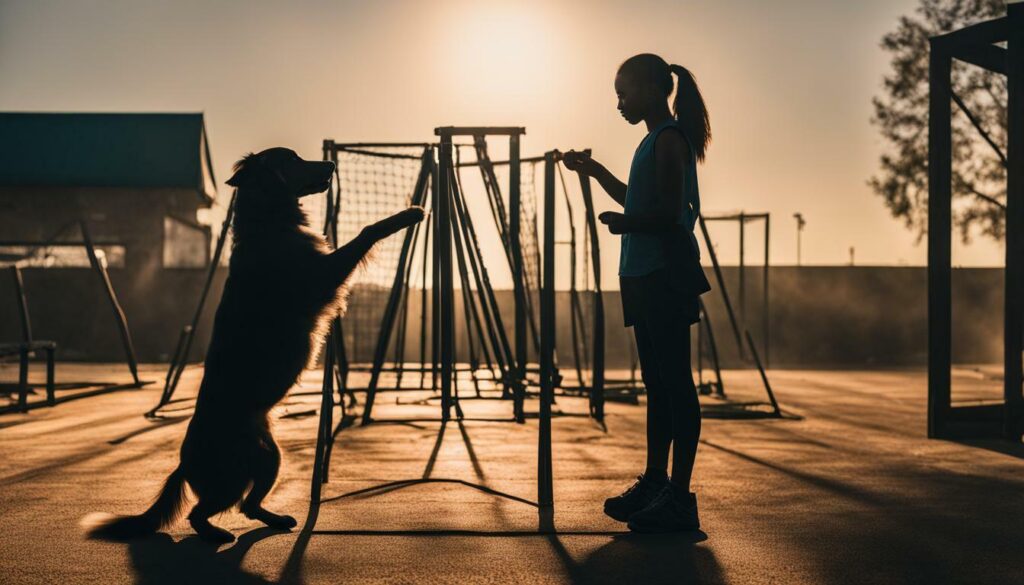
Effective dog training relies on consistent and persistent effort and the use of positive reinforcement techniques. By staying committed to your dog’s training and consistently applying the techniques outlined in this guide, you can achieve long-term success in altering unwanted behaviors and fostering a well-behaved and obedient companion.
Seeking Professional Training Help
While many dog behavior issues can be addressed through consistent and effective training techniques, some complex problems may require the help of a professional dog trainer. Seeking assistance from a professional can be helpful in preventing unwanted dog behavior and finding effective ways to train a dog to stop.
Professional trainers have the knowledge and experience needed to identify the underlying causes of behavior issues and develop customized training plans to address them. They can also provide valuable guidance and support throughout the training process to ensure long-term success.
If you’re considering professional training help, it’s essential to find a reputable and experienced trainer. Look for a trainer who uses humane and positive reinforcement methods and has a track record of successfully addressing behavior problems similar to your dog’s.
Remember, seeking professional help is not a sign of failure but rather a way to ensure the best possible outcome for your furry friend. With the right training and support, you can prevent unwanted dog behavior and enjoy a happy and well-behaved companion.

Training your dog requires effort, patience, and consistency. Along the way, it’s essential to celebrate your furry friend’s progress and build a strong bond. Remember, training is not just about stopping unwanted behaviors – it’s also an opportunity to deepen the relationship with your dog.
One effective way to build a bond with your dog is through positive reinforcement. Consistently rewarding your dog for good behavior is an important aspect of training. Praising your dog and giving treats and toys will help reinforce the positive behaviors you want to see more of.
Another way to build a bond with your dog is through regular obedience training. Obedience training not only teaches your dog new skills, but it also strengthens the bond between you and your furry friend. Training should be an enjoyable activity for both you and your dog.
Don’t be afraid to try new things or incorporate new training techniques into your routine. Learning new tricks and commands can be fun and engaging for your dog. It’s also a great way to stimulate their minds and prevent boredom.
Remember, training is a journey, not a destination. Be patient and consistent, and you’ll see results. While achieving a well-behaved dog takes time, effort, and dedication, it’s worth it in the end. Enjoy the benefits of a harmonious home environment with your well-trained and happy canine companion.
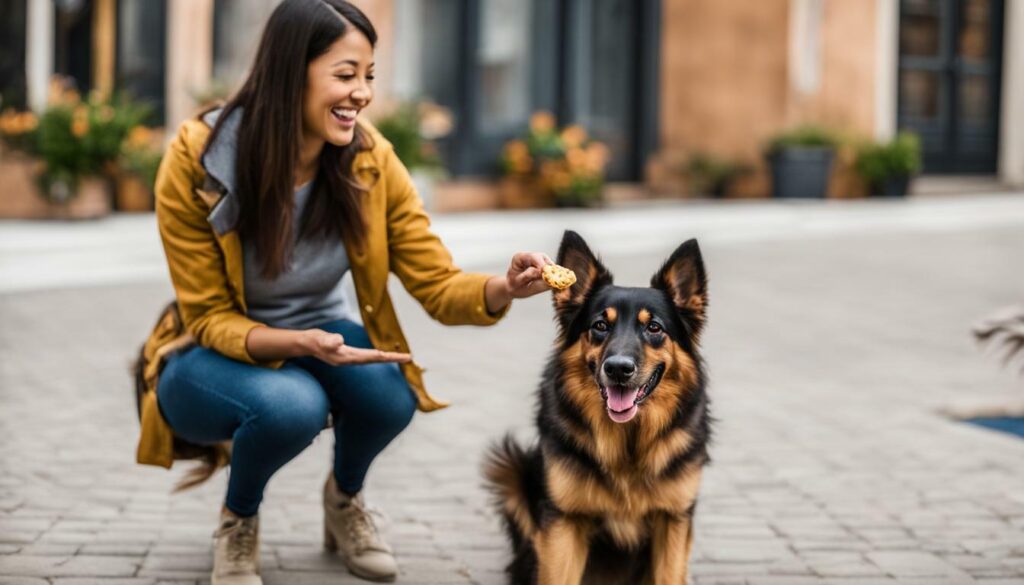
Congratulations on taking the first step towards training your dog to stop unwanted behaviors! By following the tips and techniques outlined in this guide, you can achieve a well-behaved and happy canine companion.
Remember, the key to successful dog training is consistency and persistence. It takes time, patience, and dedication to see results. But with the right approach and mindset, you can overcome even the most challenging behavior issues.
As you continue your dog training journey, take time to celebrate your dog’s progress and reinforce positive behaviors. Consistent training and positive reinforcement will help build a strong bond between you and your furry friend.
Whether you’re dealing with excessive barking, jumping, or leash pulling, the strategies outlined in this guide can help. And if you ever feel overwhelmed or unsure, don’t hesitate to seek the assistance of a professional dog trainer.
Enjoy the benefits of a well-trained dog and a harmonious home environment. Remember, with patience, consistency, and dedication, you can achieve your dog training goals and enjoy a happy and healthy relationship with your furry companion.
FAQ
How can I train my dog to stop unwanted behaviors?
In this comprehensive guide, you’ll learn the top techniques on how to train a dog to stop unwanted behaviors immediately. Discover simple and practical tips for effective results and achieve peace at home now!
Why is dog training important?
Before diving into the specifics of training a dog to stop unwanted behaviors, it’s crucial to understand the importance of dog training. Explore effective dog obedience training techniques to prevent and address unwanted behavior issues.
How do I establish leadership and trust with my dog?
Building a strong foundation with your dog is vital for successful training. Learn how to establish leadership and trust to create a calm and responsive canine companion. Discover expert dog training tricks to stop unwanted behaviors.
What are some positive reinforcement techniques for dog training?
Positive reinforcement is a proven and humane approach to dog training. Gain valuable insights into using positive reinforcement techniques to stop unwanted behaviors. Find practical dog training tips to put an end to problematic behavior patterns.
How can I teach my dog the “stop” command?
Training your dog to respond to the “stop” command is an essential skill. Discover step-by-step instructions on how to teach your dog the “stop” command effectively. Learn techniques to ensure your dog listens and stops unwanted behaviors promptly.
What can I do to stop my dog from jumping on people?
Jumping can be an annoying and potentially dangerous behavior. Learn proven methods to train your dog to stop jumping on people. Explore effective dog training tips to eliminate this unwanted behavior.
How can I control excessive barking in my dog?
Excessive barking can disrupt household harmony. Discover strategies to control and reduce your dog’s barking. Learn effective dog training tips to teach your furry friend appropriate barking behavior.
What techniques can help with separation anxiety in dogs?
Separation anxiety can cause distress to both dogs and their owners. Explore techniques to help your dog feel more comfortable when left alone. Learn valuable dog training tips to alleviate separation anxiety and promote calmness.
How can I teach my dog patience and impulse control?
Impulse control is crucial for a well-behaved dog. Discover exercises and games to teach your dog patience and self-control. Learn effective dog obedience training techniques to stop impulsive behaviors.
What can I do to address aggressive behavior in my dog?
Aggression can be a serious issue that requires professional guidance. However, there are steps you can take to manage and mitigate aggressive behaviors. Explore effective methods to train your dog to stop aggressive behavior.
How do I stop my dog from pulling on the leash?
Leash pulling can make walks frustrating and uncomfortable. Learn how to train your dog to walk politely on a leash. Discover practical dog training tips to eliminate leash pulling and promote enjoyable walks.
How can I help my dog overcome fear and anxiety?
Fear and anxiety can significantly impact a dog’s behavior and well-being. Explore techniques to help your dog overcome fear and anxiety. Learn effective ways to train your dog to stop fearful or anxious behaviors.
Why is consistency important in dog training?
Consistency and persistence are key to successful dog training. Understand the importance of consistency and learn how to maintain it throughout the training process. Discover effective dog obedience training techniques to ensure long-term behavior changes.
When should I seek professional training help?
In some cases, professional help may be necessary to address complex behavior issues. Learn when it’s appropriate to seek the assistance of a professional dog trainer. Find resources to help you find a reputable trainer in your area.
How can I celebrate progress and build a strong bond with my dog?
Training your dog is a journey that requires patience and dedication. Learn how to celebrate your dog’s progress and build a strong bond along the way. Discover additional dog training tricks to reinforce positive behaviors and create a harmonious relationship.
How can I train my dog to stop unwanted behaviors?
By implementing the techniques and tips mentioned in this guide, you can successfully train your dog to stop unwanted behaviors. Enjoy the benefits of a well-behaved canine companion and a harmonious home environment.
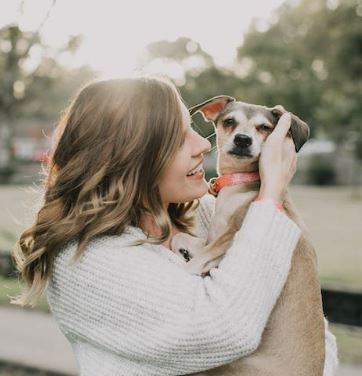
Marissa Delotta, 36, from Dayton, Ohio, is the creative force behind Roverboard.com, a beloved online destination for dog lovers. As a dedicated mom and canine enthusiast, Marissa combines her family experiences with her love for dogs to offer a platform where dog owners can exchange tips, heartwarming stories, and advice. Her website has become a vibrant community for sharing the joys of dog parenting. In her free time, Marissa enjoys exploring dog parks with her family and volunteering at local animal shelters.

